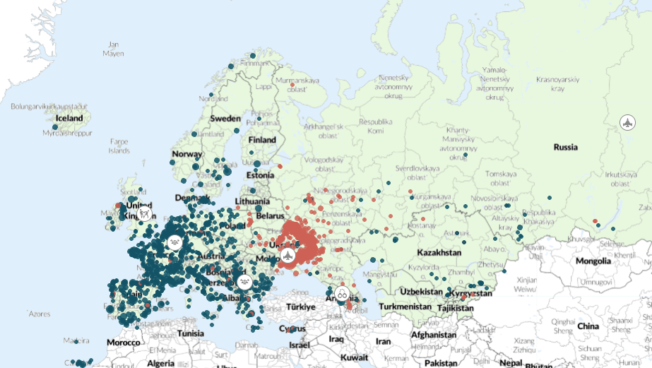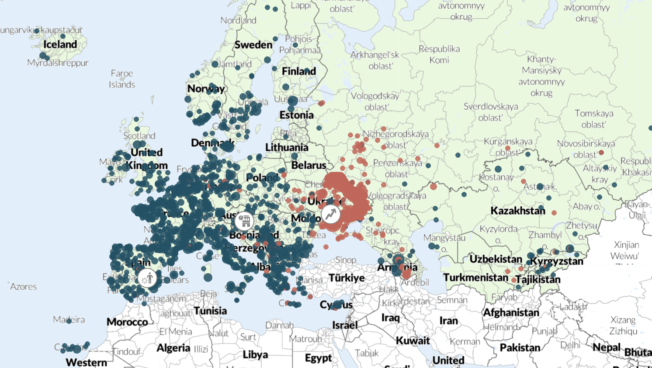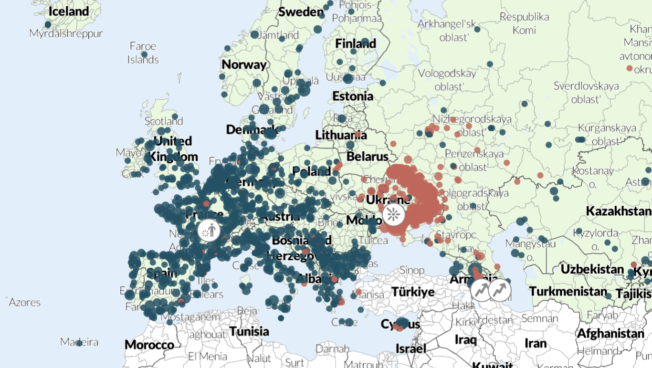Regional Overview
Europe, Caucasus and Central Asia
January 2025
Posted: 15 January 2025
In this Regional Overview covering December 2024
- European Union: French and Polish farmers’ pushback against EU-Mercosur trade deal spreads
- Georgia: Ruling party remains undeterred despite demonstrations
- Russia: Ukraine targets officials enabling the war effort
- Ukraine: Russia intensifies its assault on the Donetsk region and strikes on energy infrastructure
European Union: French and Polish farmers’ pushback against EU-Mercosur trade deal spreads
In December, farmer demonstrations against the trade agreement between the European Union and Mercosur — South America’s main trade bloc — spread from France and Poland to other EU countries, including Germany, Belgium, and Spain. The spillover coincided with reports that the European Commission was wrapping up a deal with Mercosur leaders — officially sealed on 6 December1Reuters, ‘What’s in the newly finalised EU-Mercosur trade accord?’ 6 December 2024 — despite France and Poland’s push to thwart the accord in its current form following a year of farmer discontent with EU agricultural policies.2Aleksandra Krzysztoszek, ‘Warsaw counts on Rome to block Mercosur deal,’ Euractiv, 9 December 2024
Starting with a wave of protests sparked by the agricultural provisions of the EU’s Green Deal,3Raf Casert, ‘Frustrated farmers are rebelling against EU rules. The far right is stoking the flames,’ Associated Press, 18 April 2024 2024 was the most active year for farmer demonstrations since ACLED began fully covering the EU in 2020. ACLED records over 5,000 farmer-led demonstrations in the region in 2024, exceeding the combined total of the previous four years. France, Poland, and Germany accounted for more than 60% of these events. Over 1,200 protests occurred in France alone — double the number of pro-Palestine and anti-Israel demonstrations recorded in the country in 2024. Poland saw over 900 protests involving farmers, nearly seven times the number of events involving other labor groups, while Germany recorded over 950 farmer protests, a movement second only to the mass rallies opposing right-wing extremism following revelations of a mass deportation plot by the far right in January.
Georgia: Ruling party remains undeterred despite demonstrations
Unrest over the ruling Georgian Dream (GD) party’s suspension of accession talks with the EU continued in Georgia, with demonstrations notching the highest number in December since April 2021. Some demonstrations in early December turned violent. Participants used fireworks and lasers in their standoff with police, who responded with water cannons and tear gas and detained at least 300 participants, some of whom were severely beaten during arrest or while in custody and are facing hefty fines.4Amnesty International, ‘Georgia: Brutal crackdown on protestors and journalists in Georgia: “They may have broken our bones, but they won’t break our spirits,”’ 13 December 2024 Masked thugs beat up participants and journalists covering the demonstrations on several occasions while police stood by. By late December, demonstrations proceeded calmly, and police scaled down the violence. As in the case of mass protests against the adoption of the foreign agent law in May 2024 following a failed attempt in March 2023, GD policy choices rather than the calls of fractured Georgian opposition rallied mass demonstrations.
The government carried out a crackdown on the opposition in response to the demonstrations. On 4 December, police raided opposition and civil society groups’ offices. They detained and beat up several opposition leaders.5Robin Fabbro, ‘Georgian police begin raids on opposition parties and protest organisers,’ OC Media, 5 December 2024; Al Jazeera, ‘Police raid Georgia opposition parties’ offices as protests continue,’ 4 December 2024 On the eve of formalizing the appointment of GD-picked candidate Mikheil Kavelashvili as president on 14 December, the GD majority in parliament banned the use of masks, fireworks, and lasers during demonstrations.6Felix Light and Lucy Papachristou, ‘Georgian parliament bans face masks and fireworks at protests,’ Reuters, 13 December 2024 Outgoing President Salome Zourabichvili viewed the appointment of her successor as unconstitutional due to the contested outcome of the parliamentary elections in October.7Euronews, ‘Georgia’s president slams her successor’s appointment as “a mockery of democracy,”’ 15 December 2024 The EU has responded to the GD’s moves by lifting visa waivers for the holders of Georgia’s diplomatic and service passports, as GD-friendly governments in Hungary and Slovakia blocked a package of sanctions against the Georgian leadership.8Jorge Liboreiro, ‘Hungary and Slovakia veto EU sanctions on Georgian officials as protests continue,’ Euronews, 16 December 2024
Russia: Ukraine targets officials enabling the war effort
On 17 December, an IED killed Igor Kirillov, a Russian general in charge of radiological defense, along with his adjutant in Moscow. Ukrainian special services claimed the assassination in retribution for Russian forces’ use of riot control agents when taking over Ukrainian positions, which reportedly led to the deaths of three Ukrainian service members and about 2,000 service members needing medical attention.9Martina Sapio, ‘Over 2,000 Ukrainian military personnel hospitalized for chemical poisoning since start of full-scale war, Ukrainian colonel says,’ The Kyiv Independent, 14 December 2024 A week earlier, unknown perpetrators killed a senior Russian missile engineer on the outskirts of Moscow.
These assassinations were emblematic of an escalating and multipronged push by Ukraine to fight the conflict on Russia’s territory in 2024. The number of Ukrainian drone strikes on Russia increased by 12 times compared to 2023. In addition to the increased targeting of border areas leading to a higher number of civilian casualties, Ukrainian forces also struck military sites, defense plants, and oil infrastructure deeper in the European part of the country. However, the delayed US authorization for long-range missile strikes allowed Russia to relocate its aircraft involved in bombing the frontline and border regions of Ukraine.10Hugh Cameron, ‘White House Confirms Russia Moved Planes Out of ATACMS Range,’ Newsweek, 5 September 2024 Furthermore, amid Russia’s grinding offensive in the Donetsk region, Ukrainian forces mounted a daring incursion into part of the Kursk region on 6 August, exposing the lack of prepared troops to defend Russia’s own territory. Russian leadership nevertheless prioritized operations in Ukraine, and North Korean soldiers joined the fight in mid-December to help clear the Ukraine-held salient in the Kursk region.
Ukraine: Russia intensifies its assault on the Donetsk region and strikes on energy infrastructure
In December, Russian forces intensified their operations from the south of Ukraine to take control of Kurakhove — a stronghold in the Donetsk region south of the key logistical hub of Pokrovsk — over which they eventually claimed control on 6 January. Russian forces also closed in on Velyka Novosilka, another fortress town further west at the junction with the Zaporizhia and Dnipropetrovsk regions, and advanced toward Kupiansk in the Kharkiv region. The Russian offensive in the Donetsk region that began on 10 October 2023 continued unabated throughout 2024, with the Ukrainian losses of the Avdiivka and Vuhledar strongholds resulting in the Russian occupation of over 120 settlements in the region. This sapped the morale of the understaffed Ukrainian troops, contributing to significant desertions and draft dodging.11Constant Méheut, ‘As Ukraine Expands Military Draft, Some Men Go Into Hiding,’ The New York Times, 21 June 2024; Shola Lawal, ‘Why is Ukraine’s army facing a desertion crisis?’ Al Jazeera, 21 October 2024 In the first half of the year, Ukrainian troops also had to ration ammunition due to the delayed passage of US aid.12Shona Murray, ‘Situation “dire” for Ukraine despite delayed US aid package,’ Euronews, 3 May 2024
On 13 December, Russian forces conducted one of the largest waves of strikes on Ukraine’s energy infrastructure after damaging or destroying 80% of coal- and gas-powered electricity generation between March and August.13The Economist, ‘Ukraine is on the defensive, militarily, economically and diplomatically,’ 26 September 2024 The strikes again led to the emergency reduction of output at Ukrainian nuclear power plants, on which Ukraine relies to survive the cold months.14International Atomic Energy Agency, ‘Update 266 – IAEA Director General Statement on Situation in Ukraine,’ 13 December 2024 Amid anticipation of ceasefire talks touted by the incoming Trump administration in the US, Russia reiterated it would not settle for less than the full occupation of four Ukrainian regions it annexed in September 2022, in addition to Crimea, which it seized in March 2014.15The Kyiv Independent, ‘Ukraine war latest: Russia sets goal to fully occupy 4 Ukrainian regions in 2025,’ 16 December 2024
For more information, see the ACLED Ukraine Conflict Monitor and Ukraine entry in ACLED’s Conflict Watchlist 2025.
See More
See the Codebook and the User Guide for an overview of ACLED’s core methodology. For additional documentation, check the Knowledge Base. Region-specific methodology briefs can be accessed below.
Links:
For additional resources and in-depth updates on the conflict in Ukraine, check our dedicated Ukraine Confict Monitor.







